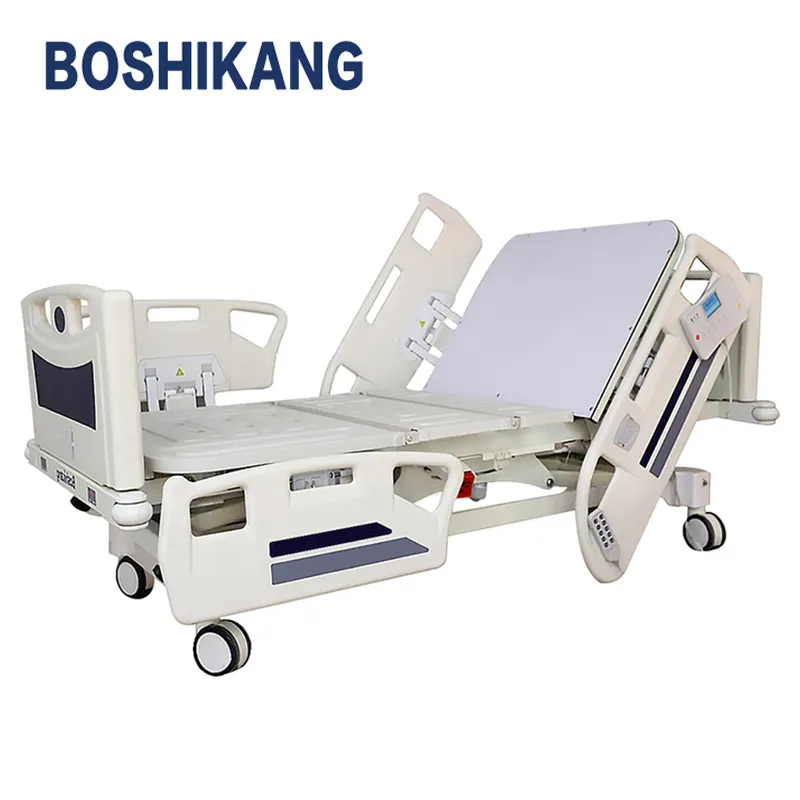Enhanced Patient Outcomes and Safety
Reducing Pressure Ulcers Through Adjustable Positioning
Hospital beds that can be adjusted are really important for preventing pressure sores, which remain a big problem across medical facilities. These sores happen when skin gets too much pressure over time, cutting off blood supply. We see them affecting around 20-25% of people staying in hospitals according to recent data. Research shows adjustable beds make a real difference in keeping these wounds at bay. The European advisory panel actually suggests moving patients regularly using these beds as part of their prevention strategy. Beyond just causing pain and suffering for those affected, pressure ulcers cost healthcare systems a fortune too. Some estimates put annual treatment expenses in the US alone somewhere north of $11 billion dollars each year, money that could go toward better patient care elsewhere.
Adjustable beds do more than just help prevent pressure sores they actually make life better for patients in many ways. When someone needs to move around or shift position during the day, these beds let them do it without struggling or risking injury. For folks in intensive care units particularly, this matters a lot since staying still too long causes all sorts of problems. The market for hospital beds keeps expanding as healthcare facilities upgrade their equipment. Adding adjustable positioning options makes sense from both clinical and business angles. Hospitals see fewer pressure ulcers developing while patients generally report feeling more comfortable throughout their recovery period. Some facilities have even noticed staff workload decreases when patients can adjust their own positions within safe limits.
Preventing Falls with Integrated Safety Features
Keeping patients from falling remains a top concern in hospitals and clinics everywhere. The good news? Hospital beds now come equipped with all sorts of safety features that actually work pretty well at stopping accidents before they happen. We're talking about things like those adjustable bed rails, alarm systems that go off when someone tries to get up too fast, and newer models designed to sit closer to the floor. Research across hundreds of medical centers shows something interesting too. When staff started using these upgraded beds consistently, fall incidents dropped anywhere between 25 to 30 percent in many cases. Not bad for an improvement that doesn't require major changes to existing protocols.
Safety features matter a lot in home healthcare too since falls happen pretty often there. Take integrated bed rails as one good example they give patients something to hold onto when getting in or out of bed. Alarm systems work alongside these rails to let staff know right away if someone tries to get up without help. Lower beds themselves make a difference too because they cut down on how far someone can fall, which means fewer serious injuries overall. The connection between fall prevention tech and better results is clear enough hospitals report quicker recoveries and fewer people coming back after discharge. For this reason, beds designed to stop falls actually do double duty improving both safety records and how satisfied patients feel about their care. These kinds of beds represent smart spending whether installed at home or in medical facilities.
Improving Respiratory Function in Critical Care
Adjustable beds really help with breathing problems, especially for those in critical condition who struggle with respiratory issues. When hospitals adjust both the head and foot sections of these beds, it actually makes a big difference in how well the diaphragm works during breathing. Studies indicate that raising the head section between 30 and 45 degrees improves how air moves through the lungs and cuts down on something called ventilator-associated pneumonia, which happens way too often in ICU settings. Clinicians have found this positioning makes a world of difference for patients hooked up to breathing machines.
Certain hospital beds come with special features that make them great for helping patients breathe better. Beds with adjustable positioning tech allow medical staff to raise patients to just the right angle for their lungs to work properly and help clear out mucus buildup. This makes a real difference in how well someone recovers from breathing issues. Money wise, hospitals save quite a bit when they avoid complications related to poor breathing. Fewer problems means less need for expensive treatments down the road. Spending on these specialized beds pays off in the long run since patients tend to get healthier faster and spend less time in the hospital recovering.
h2Cost-Efficiency and Resource Optimization
Long-Term Savings with Durable Hospital Bed Designs
Healthcare facilities that invest in sturdy hospital bed designs typically save money over time. Adjustable beds in particular cut down on the constant need for repairs and replacements that drain budgets month after month. Research indicates these durable beds last much longer than their basic counterparts, which means hospitals get better value for their upfront spending. Take numbers for example: standard hospital beds tend to last around 5 to 7 years before needing replacement, whereas the good quality ones keep working well for anywhere between 10 to 15 years. That kind of longevity adds up to real savings when looking at the big picture. When hospital administrators start thinking about where to find reliable equipment, checking out local suppliers through phrases like "hospital beds for sale near me" helps them discover practical solutions that fit both budget constraints and actual patient care needs.
Streamlining Workflows for Staff Efficiency
Adjustable hospital beds really make a difference when it comes to making work easier for hospital staff. These beds save nurses and caregivers hours every day because they spend less time manually moving patients around or adjusting positions. Most models come with features that anyone can operate quickly - just think about how simple it is to change bed height, those handy wheels for moving the whole unit, and remote controls that let staff adjust everything from across the room. Hospitals that switched to these adjustable beds report better numbers on their efficiency charts, plus workers actually get to spend more quality time with patients instead of wrestling with equipment. Better workflows mean happier staff overall, which naturally translates into better care for everyone. That's why adjustable beds are becoming standard even outside traditional hospitals, finding their way into homes where seniors need extra support during recovery periods.
Comparing Hospital Bed Mattress Price vs. Value
When looking at hospital bed mattresses, healthcare providers need to weigh not just what they cost but also how well they actually work for patients comfort and overall recovery. Some facilities go for the cheapest available option, but this approach can backfire badly. Good quality mattresses really matter because they help avoid those painful pressure sores and actually make breathing easier for many patients. Industry studies consistently show that while top tier mattresses might set hospitals back more upfront money wise, these investments pay off over time through better patient outcomes and longer product life. Finding the sweet spot between hospital bed mattress prices and actual performance makes financial sense too since hospitals spend far less on treatments down the road when patients heal properly. Premium adjustable beds aren't just fancy gadgets they represent smart spending decisions that benefit everyone involved.
Compliance with Evolving Healthcare Standards
Meeting HIPAA Requirements for Smart Medical Beds
Medical beds with smart technology need to follow HIPAA rules if they want to keep patient info private and secure. Many modern hospital beds now come loaded with all sorts of sensors that track everything from vital signs to movement patterns. This means hospitals have to put serious security systems in place so nobody gets their hands on confidential medical records. We've seen plenty of cases where clinics got hit with huge fines because they messed up on HIPAA compliance. One hospital paid over $3 million after an employee accidentally sent protected health information to the wrong email address. As manufacturers continue adding new tech features to hospital beds, they'll find themselves walking a tightrope between innovation and regulation. The way these smart functions get implemented will depend heavily on whether they can pass strict privacy tests first.
Adapting to ICU Bed Safety Regulations
Hospital beds designed for adjustment have been modified according to the most current safety rules specifically for ICU environments. These regulations keep getting revised regularly to protect both patients and medical staff better. The newest requirements demand certain must-have features including height and angle adjustments, emergency stop buttons, plus sophisticated monitoring equipment that helps improve overall patient treatment. Most modern ICU beds come equipped with built-in side rails and effective braking mechanisms so they can follow all the latest safety protocols. With tech developments happening fast in intensive care units across the country, manufacturers are pushing boundaries when creating beds that go beyond just meeting basic regulations. Their goal is simple really – create safer, more efficient solutions for those receiving critical care.
Integrating Infection Control Protocols
Keeping infections under control remains essential across all healthcare environments, and adjustable beds actually help make this happen. Beds with surfaces that wipe down easily and materials that stop germs from spreading cut down on those nasty hospital acquired infections we all want to avoid. Real world data shows hospitals that switch to these newer bed models tend to report fewer infection cases overall. Research connecting better infection control features in hospital beds to actual improvements in how patients recover makes sense when thinking about it. For hospitals trying to maintain good standards while also providing quality care, spending money on beds with these infection fighting properties just makes good business sense in the long run.

Caregiver and Staff Benefits
Ergonomic Design Reduces Physical Strain
Adjustable beds designed with ergonomics in mind help reduce the physical toll on caregivers when moving patients around. These beds come with features like adjustable heights and sturdy side rails that make lifting and repositioning much less strenuous for the people doing the work. Studies indicate that when hospitals adopt these kinds of ergonomic improvements, we see better health outcomes for staff members and fewer days lost due to sick leave. This matters because it cuts down on workplace injuries too. When manufacturers focus on making their products more ergonomically friendly, they create safer conditions for workers while at the same time boosting productivity across the board for those who rely on home health care equipment daily.
Automated Features for Patient Monitoring
Adjustable beds with automated functions really help out caregivers because they take over a lot of the work involved in keeping track of patients. The beds come equipped with all sorts of sensors that monitor things like heart rate and breathing patterns, so any weird changes get noticed much sooner than before. We've seen plenty of instances where these systems caught problems early enough to make a big difference in outcomes. For nursing staff, this means spending less time staring at monitors and more time actually talking to patients face to face. That shift makes all the difference in how people feel when they're recovering at home in what used to be hospital grade equipment.
Simplifying Patient Transfers and Repositioning
Adjustable beds make it much easier to move patients around and change their positions, which cuts down on injuries for everyone involved. We all know how dangerous those old fashioned manual transfers can be. The numbers back this up too many people get hurt during these transfers. That's where adjustable beds come in handy. They have things like motors that adjust height and allow multiple positions, so moving becomes much safer overall. Beyond keeping patients safe, these beds actually boost how happy caregivers are with their jobs. When staff members don't worry about getting hurt while doing their work, they tend to do better at what they do. This makes a real difference in hospitals as well as home care situations where proper positioning matters a lot.


